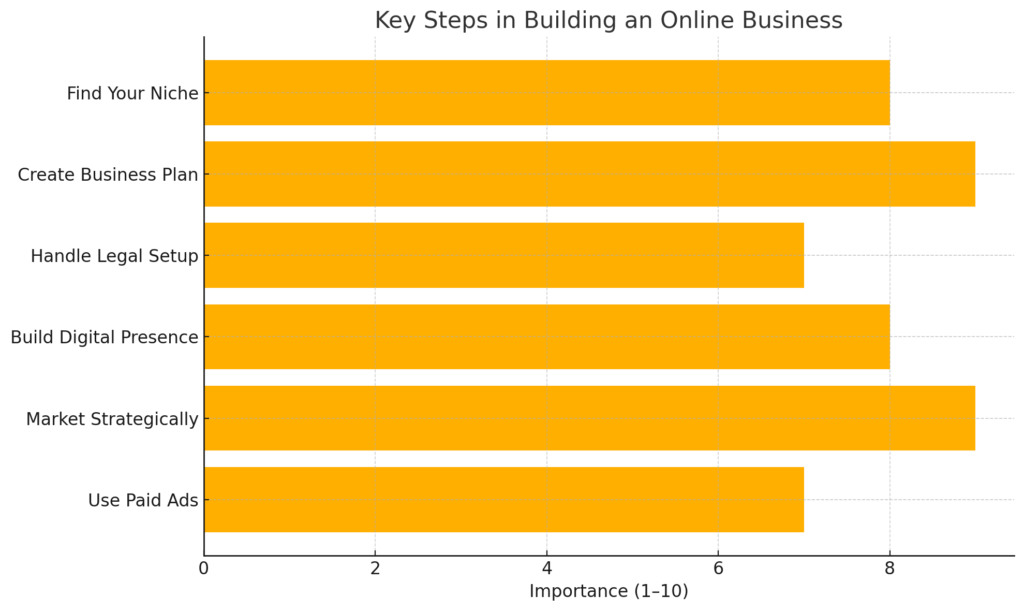
E-commerce has revolutionized how we shop—what once seemed novel is now second nature. From groceries to gadgets, consumers are turning to online platforms for convenience, speed, and variety.
Knowing how to start-up an online business. This transformation didn’t happen overnight. It’s the result of rapid internet expansion, mobile accessibility, and advanced digital tools.
As traditional retail struggles to keep pace, businesses are shifting online to reach broader audiences. Fortunately, launching an online business has never been more accessible. With the right strategy and mindset, you can carve out your niche in the vast digital marketplace and scale with confidence.
1. Zeroing In on Your Ideal Niche
In the expansive online space, finding your niche is essential. Without clear focus, it’s easy to blend into the crowd. A well-defined niche positions you as an expert, helps you connect deeply with a specific audience, and streamlines your marketing efforts.
Steps to Identify Your Niche:

- Conduct Market Research
Use tools like Google Trends, social media insights, and industry reports to uncover gaps in the market. - Explore Online Communities
Forums such as Reddit, Quora, and niche Facebook groups can reveal recurring pain points and unmet needs. - Follow Social Media Trends
Monitor Instagram, TikTok, and Twitter for emerging interests and changing consumer behaviors.
Validate Your Niche:
- Gather Real Feedback
Test ideas through surveys, pilot launches, or beta groups. - Refine Based on Input
Let customer feedback shape your final product or service offering.
✅ Tip: Choose a niche that aligns with both market demand and your passion. When you’re genuinely excited about your offering, that energy fuels consistency and innovation.
2. How to Make a Great Business Plan
With your niche in place, the next step is strategy. A business plan is more than paperwork—it’s your strategic compass. It guides your decisions, defines your goals, and serves as a vital tool if you’re seeking funding or partnerships.
Key Components of a Business Plan:
- Target Audience
Define who you’re serving. Understand their habits, preferences, and pain points. - SMART Goals
Structure your objectives so they’re:- Specific
- Measurable
- Achievable
- Relevant
- Time-bound
- Unique Value Proposition (UVP)
What makes your product or service stand out? Clarify your competitive edge. - SWOT Analysis
Understand your:- Strengths: What gives you an advantage?
- Weaknesses: Where do you need improvement?
- Opportunities: What trends or gaps can you tap into?
- Threats: What external risks could challenge your growth?
🎯 A strong business plan keeps you focused and aligned with long-term goals while allowing for flexibility as your business grows.
3. Navigating Legal Requirements & Formalities
Legal considerations may not be glamorous, but they’re critical. Establishing your business correctly from day one helps you avoid headaches later.
Legal Essentials:
- Choose a Legal Structure
Options include:- Sole Proprietorship
- Limited Liability Company (LLC)
- Corporation
Each affects your taxes, liability, and compliance responsibilities differently.
- Register Your Business Name and Domain
Ensure your chosen name is available and legally protected. Secure a matching domain to build brand consistency. - Obtain Required Permits and Licenses
Depending on your product and location, you may need sales permits, reseller licenses, or tax IDs. - Protect Intellectual Property
Trademark names, logos, and any proprietary content to safeguard your brand identity.
📌 Consider consulting a legal expert to ensure full compliance with local and federal regulations.
4. Establishing Your Digital Presence
Your website or platform is your storefront—it’s where first impressions are made. Make sure it’s welcoming, functional, and reflective of your brand.
Steps to Build a Strong Digital Presence:
- Select the Right E-Commerce Platform
Options like Shopify, WooCommerce, BigCommerce, or Etsy vary based on product type and technical comfort. - Ensure Mobile Optimization
With over 50% of online shopping happening on mobile devices, responsiveness is non-negotiable. - Implement SEO Best Practices
Use relevant keywords, create high-quality content, and optimize meta descriptions to improve visibility in search engines. - Secure Your Checkout Process
Choose trusted payment gateways like PayPal, Stripe, or Square. A smooth, secure transaction builds credibility.
🛠 Before launch, thoroughly test your site for usability, speed, and mobile compatibility.
5. Creating Content & Marketing Strategically
In the digital space, content builds trust and drives engagement. It’s not just about selling—it’s about connecting, educating, and offering value.
Content Marketing Essentials:
- Develop a Content Strategy
Include blog posts, how-to videos, product tutorials, and customer stories. - Maintain a Content Calendar
Consistent publishing keeps your brand active and boosts SEO rankings. - Utilize Email Marketing
Send welcome emails, nurture sequences, promotions, and newsletters to stay top-of-mind. - Leverage Social Media
Use platforms like Instagram, TikTok, and LinkedIn to engage with your audience—post consistently and interact authentically. - Cross-Promote with Other Brands
Partnerships with complementary businesses can expand your reach. - Track and Adjust
Use analytics tools (e.g., Google Analytics, social insights) to refine your approach.
📈 The most effective marketing is data-driven. Let the numbers guide your next move.
6. Tips for Advertising with Social Media
Organic reach is powerful, but scaling often requires paid strategy. Paid ads help drive traffic, gather leads, and convert browsers into buyers.
Online Advertising Tactics:
- Targeted Ads
Platforms like Facebook, Instagram, and Google Ads let you target by location, behavior, interest, and more. - PPC (Pay-Per-Click)
Cost-effective and measurable. Start with a small budget, analyze results, and scale what performs best. - Display Advertising
Banner ads and visual placements across websites improve brand awareness. - Retargeting Campaigns
Reconnect with users who visited your site but didn’t convert—these campaigns often yield high ROI.
🧠 Monitor performance metrics like click-through rates, conversion rates, and customer acquisition cost to ensure your ad spend is justified.
Final Thoughts
Launching and scaling an online business is both an exciting opportunity and a demanding challenge. It requires:
- Clear strategy
- Consistent branding
- Legal awareness
- Smart marketing
- Willingness to learn and pivot
With focus, creativity, and resilience, you can build an online business that not only generates income—but creates real impact.
